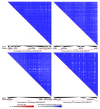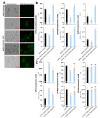Genome Evolutionary Dynamics Meets Functional Genomics: A Case Story on the Identification of SLC25A44
- PMID: 34073512
- PMCID: PMC8199184
- DOI: 10.3390/ijms22115669
Genome Evolutionary Dynamics Meets Functional Genomics: A Case Story on the Identification of SLC25A44
Abstract
Gene clusters are becoming promising tools for gene identification. The study reveals the purposive genomic distribution of genes toward higher inheritance rates of intact metabolic pathways/phenotypes and, thereby, higher fitness. The co-localization of co-expressed, co-interacting, and functionally related genes was found as genome-wide trends in humans, mouse, golden eagle, rice fish, Drosophila, peanut, and Arabidopsis. As anticipated, the analyses verified the co-segregation of co-localized events. A negative correlation was notable between the likelihood of co-localization events and the inter-loci distances. The evolution of genomic blocks was also found convergent and uniform along the chromosomal arms. Calling a genomic block responsible for adjacent metabolic reactions is therefore recommended for identification of candidate genes and interpretation of cellular functions. As a case story, a function in the metabolism of energy and secondary metabolites was proposed for Slc25A44, based on its genomic local information. Slc25A44 was further characterized as an essential housekeeping gene which has been under evolutionary purifying pressure and belongs to the phylogenetic ETC-clade of SLC25s. Pathway enrichment mapped the Slc25A44s to the energy metabolism. The expression of peanut and human Slc25A44s in oocytes and Saccharomyces cerevisiae strains confirmed the transport of common precursors for secondary metabolites and ubiquinone. These results suggest that SLC25A44 is a mitochondrion-ER-nucleus zone transporter with biotechnological applications. Finally, a conserved three-amino acid signature on the cytosolic face of transport cavity was found important for rational engineering of SLC25s.
Keywords: SLC25 subfamily 44; candidate gene; electron transfer chains; flavonoids; gene clusters; gene organization; genomic co-localization; para-coumaric acid; resveratrol; ubiquinone.
Conflict of interest statement
The authors declare no conflict of interest.
Figures









Similar articles
-
The GBA-370Rec Parkinson's disease risk haplotype harbors a potentially pathogenic variant in the mitochondrial gene SLC25A44.Mol Genet Metab. 2021 May;133(1):109-112. doi: 10.1016/j.ymgme.2021.03.012. Epub 2021 Mar 18. Mol Genet Metab. 2021. PMID: 33762134
-
Evolution, structure and function of mitochondrial carriers: a review with new insights.Plant J. 2011 Apr;66(1):161-81. doi: 10.1111/j.1365-313X.2011.04516.x. Plant J. 2011. PMID: 21443630 Review.
-
Conservation of amino acid transporters in fungi, plants and animals.Trends Biochem Sci. 2002 Mar;27(3):139-47. doi: 10.1016/s0968-0004(01)02054-0. Trends Biochem Sci. 2002. PMID: 11893511 Review.
-
A comprehensive evolutionary classification of proteins encoded in complete eukaryotic genomes.Genome Biol. 2004;5(2):R7. doi: 10.1186/gb-2004-5-2-r7. Epub 2004 Jan 15. Genome Biol. 2004. PMID: 14759257 Free PMC article.
-
A cluster of proton/amino acid transporter genes in the human and mouse genomes.Genomics. 2003 Jul;82(1):47-56. doi: 10.1016/s0888-7543(03)00099-5. Genomics. 2003. PMID: 12809675
Cited by
-
Heterologous (Over) Expression of Human SoLute Carrier (SLC) in Yeast: A Well-Recognized Tool for Human Transporter Function/Structure Studies.Life (Basel). 2022 Aug 8;12(8):1206. doi: 10.3390/life12081206. Life (Basel). 2022. PMID: 36013385 Free PMC article. Review.
-
The GCKR-P446L gene variant predisposes to raised blood cholesterol and lower blood glucose in the P446L mouse-a model for GCKR rs1260326.Mol Metab. 2023 Jun;72:101722. doi: 10.1016/j.molmet.2023.101722. Epub 2023 Apr 7. Mol Metab. 2023. PMID: 37031802 Free PMC article.
-
Selective loss of ATP carriers in favour of SLC25A43 orthologues in metamonad mitochondria adapted to anaerobiosis.Open Biol. 2025 Aug;15(8):240202. doi: 10.1098/rsob.240202. Epub 2025 Aug 13. Open Biol. 2025. PMID: 40795994 Free PMC article.
References
MeSH terms
Substances
LinkOut - more resources
Full Text Sources
Molecular Biology Databases
Research Materials

